Introductory Session
MPH Program - Mission Statement
The mission of the Virginia Commonwealth University MPH program is to engage students in an experiential, learner-centered environment, collaborate with public health partners in central Virginia to promote health equity and community wellness, and foster life-long inquiry and discovery in interdisciplinary, translational research that improves human health.
VCU Statements for Syllabi and Blackboard Pages. (V.2017)
Topics include:
- Campus emergency information
- Class registration required for attendance
- Honor System: upholding academic integrity
- Important dates
- Managing stress
- Mandatory responsibility of faculty members to report incidents of sexual misconduct
- Military short-term training or deployment
- Student conduct in the classroom
- Student email policy
- Student financial responsibility
- Students representing the university - excused absences
- Students with disabilities
- Withdrawal from classes
What to know and do to be prepared for emergencies at VCU:
- Sign up to receive VCU text messaging alerts. Keep your information up-to-date. Within the classroom, the professor will keep his or her phone on to receive any emergency transmissions.
- Know the safe evacuation route from each of your classrooms. Emergency evacuation routes are posted in on-campus classrooms.
- Listen for and follow instructions from VCU or other designated authorities. Within the classroom, follow your professor's instructions.
- Know where to go for additional emergency information.
- Know the emergency phone number for the VCU Police (828-1234).
- Report suspicious activities and objects.
- Keep your permanent address and emergency contact information current in eServices.
Class registration required for attendance
Students may attend only those classes for which they have registered. Faculty may not add students to class rosters or Blackboard. Therefore, if students are attending a class for which they have not registered, they must stop attending.
Honor System: upholding academic integrity
The VCU Honor System policy describes the responsibilities of students, faculty and administration in upholding academic integrity, while at the same time respecting the rights of individuals to the due process offered by administrative hearings and appeals. According to this policy, "Members of the academic community are required to conduct themselves in accordance with the highest standards of academic honesty, ethics and integrity at all times." In addition, “To support a commitment to the Honor System, all members of the VCU community are required to:
- Adhere to the Honor System policy and its procedures;
- Report any suspicion or knowledge of possible violations of the Honor System;
- Answer truthfully when called upon to do so regarding Honor System matters;
- Maintain appropriate confidentiality regarding related to Honor System matters."
More information can be found at in the VCU policy library.
You can view important dates for the semester in the academic calendar.
Students may experience situations or challenges that can interfere with learning and interpersonal functioning including stress, anxiety, depression, alcohol and/or other drug use, concern for a friend or family member, loss, sleep difficulties, feeling hopeless or relationship problems. There are numerous campus resources available to students including University Counseling Services (804-828-6200 MPC Campus, 804-828-3964 MCV Campus), University Student Health Services (MPC 804 828-8828, MCV Campus 804 828-9220) and the Wellness Resource Center (804-828-9355). 24 hour emergency mental health support is available by calling 828-1234 and asking to speak to the on-call therapist or utilizing the National Suicide Prevention Lifeline (1-800-784-2433).
Mandatory responsibility of faculty members to report incidents of sexual misconduct
It is important for students to know that all faculty members are mandated reporters of any incidents of sexual misconduct/violence (e.g., sexual assault, sexual exploitation and partner or relationship violence). This means that faculty cannot keep information about sexual misconduct/violence confidential if you share that information with them and they must report this information immediately to the university's Title IX Coordinator. In addition, department chairs, deans, and other unit administrators are required to report incidents of sex or gender-based discrimination to the university's Title IX Coordinator. Once a report is made, you will receive important information on your reporting options, on campus and off campus resources and remedial measures such as no-contact directives, residence modifications, and academic modifications. If you would prefer to speak with someone confidentially for support and to discuss your options for reporting, contact:
- VCU's Wellness Resource Center 804.828.9355 | myoptions@vcu.edu | thewell.vcu.edu
- Greater Richmond Regional Hotline (Community program) 804.612.6126 | 24-hour hotline
- VCU’s Counseling Services 804-828-6200
For more information on how to help, please click here. The Policy on Sexual Misconduct/Violence and Sex/Gender Discrimination, can be found in the VCU policy library. For more information about the University's Title IX process, please visit equity.vcu.edu.
Military short-term training or deployment
If military students receive orders for short-term training or for deployment/mobilization, they should inform and present their orders to Military Student Services and to their professor(s). For further information on policies and procedures contact Military Student Services at 828-5993 or access the corresponding policies.
Student conduct in the classroom
According to the Faculty Guide to Student Conduct in Instructional Settings, "The university is a community of learners. Students, as well as faculty, have a responsibility for creating and maintaining an environment that supports effective instruction. In order for faculty members (including graduate teaching assistants) to provide and students to receive effective instruction in classrooms, laboratories, studios, online courses, and other learning areas, the university expects students to conduct themselves in an orderly and cooperative manner." Among other things, cell phones should be turned off while in the classroom. The Student Code of Conduct also prohibits the possession of or carrying of any weapon. For more information see http://register.dls.virginia.gov/details.aspx?id=3436.
Email is considered an official method for communication at VCU because it delivers information in a convenient, timely, cost-effective, and environmentally aware manner. Students are expected to check their official VCU email on a frequent and consistent basis in order to remain informed of university-related communications. The university recommends checking email daily. Students are responsible for the consequences of not reading, in a timely fashion, university-related communications sent to their official VCU student email account. This policy ensures that all students have access to this important form of communication. It ensures students can be reached through a standardized channel by faculty and other staff of the university as needed. Mail sent to the VCU email address may include notification of university-related actions, including disciplinary action. Please read the policy in its entirety at the VCU Policy Library.
Student financial responsibility
Students assume the responsibility of full payment of tuition and fees generated from their registration and all charges for housing and dining services, and other applicable miscellaneous charges. Students are ultimately responsible for any unpaid balance on their account as a result of the University Financial Aid Office or their third party sponsor canceling or reducing their award(s).
Students representing the university – excused absences
Students who represent the university (athletes and others) do not choose their schedules. Student athletes are required to attend games and/or meets. All student athletes should provide their schedules to their instructors at the beginning of the semester. The Intercollegiate Athletic Council strongly encourages faculty to treat missed classes or exams (because of a scheduling conflict) as excused absences and urges faculty to work with the students to make up the work or exam.
Section 504 of the Rehabilitation Act of 1973 and the Americans with Disabilities Act of 1990, as amended, require that VCU provide "academic adjustments" or "reasonable accommodations" to any student who has a physical or mental impairment that substantially limits a major life activity. To receive accommodations, students must register with the Disability Support Services Office on the Monroe Park Campus (828-2253) or the Division for Academic Success on the MCV campus (828-9782). Please also visit the Disability Support Services website and/or the Division for Academic Success website for additional information.
Once students have completed the DSS registration process, they should schedule a meeting with their instructor (s) and provide their instructor (s) with an official DSS accommodation letter. Accommodation letters will outline the required classroom accommodations. Additionally, if coursework requires the student to work in a lab environment, the student should advise the instructor or a department chairperson of any concerns that the student may have regarding safety issues related to a disability. Students should follow this procedure for all courses in the academic semester.
Before withdrawing from classes, students should consult their instructor as well as other appropriate university offices. Withdrawing from classes may negatively impact a student’s financial aid award and his or her semester charges. To discuss financial aid and the student bill, visit the Student Services Center at 1015 Floyd Avenue (Harris Hall) and/or contact your financial aid counselor regarding the impact on your financial aid.
January 2017
Curriculum Vita: CMGB
Course Objectives:
On completion of this course students will be able to identify the effects of chronic disease upon the health of the population; in terms of Years of Life Lost, disability, economic effect on the health care system, and the points at which primary and secondary prevention work. Students will also be able to identify likely interventions that will improve the outcome of particular chronic diseases and discuss the transitional research needed to accomplish these outcomes. This is not a course in epidemiology but a course in how to use descriptive epidemiology:
to examine each topic discussed. As part of the epidemiology of these the diseases we will also look at some of the major risk factors that influence the progression of these diseases, in particular the role of ageing and addiction (using tobacco addiction as a model).incidence, prevelance, geographic distribution, age distribution and economic distribution
Course Competencies:
|
MPH COMPETENCIES - PHP/EPI |
| Biostatistics | |
| A.8 | Apply basic informatics techniques with vital statistics and public health records in the description of public health characteristics and in public health research and evaluation. |
Epidemiology |
|
C.4 |
Explain the importance of epidemiology for informing scientific, ethical, economic and political discussion of health issues. |
C.10 |
Evaluate the strengths and limitations of epidemiologic reports. |
|
Health Policy (HP) |
D.1 |
Identify the main components and issues of the organization, financing and delivery of health services and public health systems in the US. |
D.4 |
Discuss the policy process for improving the health status of populations. |
|
Social and Behavioral Health |
E.8 |
Apply evidence-based approaches in the development of social and behavioral interventions |
|
Diversity & Culture |
G.2 |
Explain how professional ethics and practices relate to equity and accountability in diverse community settings. |
|
Ethical behaviors and leadership skills |
J.3 |
Apply evidence-based principles and the scientific knowledge base to critical evaluation and decision-making in public health. |
Methods.
Student groups will prepare some of the weekly presentations, faculty will present others as models, on one of the major chronic disease Issues found at (but not limited to) http://www.cdc.gov/chronicdisease/index.htm . Each week the job of the student presenter(s) will be first to identify the prevalence and incidence of the disease topic of the week, explain why such information may be lacking, what resources were used to obtain the information, what should be done to improve the information. If information is found the presenter should discuss the reliability and validity of the data. Then the presenter should discuss what is known about the financial impact of this disease upon the health care system. Finally the presenter(s) should discuss major research efforts being supported by national organizations and lead a discussion on potential additional research. The focus should not be on bench research but on translational research that can be applied to populations with outcome measurements.. Suggested data, papers, publications will be provided to help develop the weekly presentations. However other sources may be used.
The presentations will focus on the distribution of the disease of the week by age CDC - Chronic Disease - Statistics and Tracking sex, race, age and geography and will include a summary of physical/mental limitation imposed by the disease and cost to the health system. Major outcome based research will be identified and an emphasis will be placed on the role of translational research as well as promising avenues of research to limit the effects of the chronic disease under discussion. See Chronic Disease Outcomes
Readings from the Internet, plus required reading Textbook:
Chronic Disease Epidemiology and Control, by Patrick Remington, Ross Brownson, and Mark Wagner. Published June 2010. This book can be obtained at the medical campus bookstore, or the second-hand bookstore on the academic campus or directly from the APHA at: http://digital.turn-page.com/i/639363-2016-pubs-cat. . It can also be obtained @Amazon.com http://www.amazon.com/Chronic-Disease-Epidemiology-Control-3rd/dp/087553192X/ref=sr_1_2?s=books&ie=UTF8&qid=1456431056&sr=1-2&keywords=epidemiology+of+chronic+disease.
For those students who have not yet taken a course in epidemiology the Supercourse epidemiology PowerPoints are used to provide a base of reference. You need to understand incidence, prevalence, sensitivity, specificity, association, as a minimum
Optional Reading,
Meeting the Challenge of Chronic Disease: Kane, Priestess and Totten. Johns Hopkins University Press, 2005.
Healthy People 2020
Journal of Chronic Diseases
Health United States – For each disease review data from this publication. Pay special attention to Morbidity & limitation of activities.
The Community Guide
Always consider evidence base from the Cochrane ReviewsTopics.
Continuing Resources to use throughout this course to supplement the specific reasonsinclude items found at:
the Kaiser Family Foundation And KFF daily news
The following will be obtained from the TML library Journal page
JAMA
NEJM
BMJ
Lancet
Health Affairs
Science
Only available on the internet are
MedPage daily news
Grading:
Evaluation and Grading Policy:
(1) Presentation weekly of three research summaries selected from the AMA morning report, ScienceDaily, MedPage and the Kaiser family foundation daily report emailed daily to you, which will include discussion by each student of reason for selection, the epidemiologic and biostatistical validity of the report as well discussion of the presentations of the other students - 20 percent.
(2) Powerpoint presentation of the topic of the week, 20% of the final grade, will require that the presenter(s) will first identify the prevalence and incidence of the topic of the week, also the mortality and morbidity contributions to the health of the population, explain why such information may be lacking, what resources were used to obtain the information, what should be done to improve the information. If information is found the presenter should discuss the reliability and validity of the data as well as the value/ non-value of screening (see the link above in the methods section), . Then the presenter will discuss what is known about the financial impact of this disease upon the health care system. Finally the presenter should discus major research efforts being supported by national organizations and lead a discussion on potential additional research. The focus should not be on bench research but on transitional research that can be applied to populations with outcome measurements.. Suggested data, papers, publications will be provided to help develop the weekly presentations
(3) The midterm exam will count for 20% of the final grade.
(4) The final exam counts for 30% : it consists of three parts,
- First: discussion on a topic that particularly interested you. Write not less than 1500 words on the topic you found most interesting, (which may not be the ones assigned to you), describing problems in finding useful data on the topic, and which important data is currently missing when trying to evaluate new interventions, and where you believe new translational research on this topic should focus at this time. (60-% final exam)
- Second, an analysis of chronic disease costs to the health system and any comments on the validity of these costs. Discuss what you believe to be the total financial cost of chronic diseases by adding up the costs identified for each particular topic in this course, realizing that we left a number of chronic diseases out of our discussions. Compare the total you get to the 17% of the GDP we currently spend on health and medical care. What problems you find in the analyses of costs by disease? (30% final exam)
- Third: an evaluation of this course and how we can improve it for the next class considering topics discussed in this course and what additional items you would out and what you would add. Did you find selecting issues to discuss from the research lists each week useful? (10% final exam.)
(5) Working as part of a team and entering into discussions on the topic presentations each week, as well as the individual reports contributes 10 percent to the final grade.
Course grading is A-F.
Grading Criteria:
Letter grades and associated points are awarded in this course as follows, and, will appear on the student’s official transcript.
A 4.00 Represents achievement that is outstanding relative to the level necessary to
meet course requirements.
B 3.00 Represents achievement that is significantly above the level necessary to
meet course requirements.
C 2.00 Represents achievement that meets the course requirements in every respect.
D 1.00 Represents achievement that is worthy of credit even though it fails to meet fully
the course requirements.
F 0.00 Represents failure and signifies that the work was completed but not at a level of
achievement worthy of credit.
My Grade Sheet
| Course week | Week 1 | Week 2 | ||||
| PPt Discssn | URLS | General Interaction | PPt & Discssn | URLs | General Iteraction | |
Sample of Grading Criteria:
A = 92 – 100 percent
B = 80 – 91 percent
C = 75 - 79 percent
D = 70 – 74 percent
F = less than 70 percent
F – Represents failure (or no credit) and signifies that the work was either 1) completed but at a level of achievement that is not worthy or credit or 2) was not completed and there was no agreement between the instructor and the student that the student would be awarded an “I”.
I – (incomplete) Assigned at the discretion of the instructor when, due to extraordinary circumstances, e.g., hospitalization, a student is prevented from completing the work of the course on time. Requires a written agreement between instructor and student. Extension for completion of the work will not exceed one semester, after which time the “I” converts to an “F”.
Readings for discussion, first session; Introduction to topics, where to find resources, examples of major research, and economic impact of chronic disease.
Chronic Diseases Text: Chapters 1 through 4. Read Chapter 1, Scan chapters 2-3 as these contain material you should have dealt with in your required Epi classes.
In chapter 2 pay attention to Figure 2.2 as you will see this format for each area of study. Then review table 2.3 and be sure all these topics have been covered in the past. Read pages 45/46. This item covers the points where about 95% of studies fall short. Be sure you understand figure 3.1. Pay attention to pages 79 through 83..
Individual papers can be viewed using the TML library e-Journals page, also use e-Journal page to review " Science" 12 September 2012 Vol 337 issue for its section on Chronic (Non Communicable) diseases and their control
Scan this Institute of Medicine, June 23, 2015 to get a feel for the state of the art.
Not only does the United States spend more per capita on medical care than any other nation, and more than twice as much as the average for all other countries in the Organisation for Economic Co-operation and Development, it spends more on medical research as well. Yet despite the high level of spending, our health outcomes are mediocre at best; the United States ranks 26th in life expectancy and 31st in infant mortality among developed nations. This discrepancy raises the question about the value derived from the governmental and nongovernmental investments in medical research. In contradistinction to basic science research, for which the goal is arguably to advance science for the development of knowledge, translational science seeks to improve health through the development of bench-to-bedside interventions and to assure their use in patients and populations that would benefit from them. To improve health measurably, translational research needs to focus on identifying interventions that are likely to provide the greatest population health benefit as well as interventions that are widely used but are ineffective or harmful. In a prior paper we proposed a set of criteria for researchers, funders, journal editors, and consumers of research to assess the importance and value of studies on health interventions—to answer the “so what” question. Those criteria include the burden of disease (quality-adjusted life years [QALYs] lost due to the condition), the preventable burden (how much health burden could be alleviated if the intervention were successful), the economic value (cost and cost-effectiveness), and the additional information gained from the study (e.g., sufficient information to change an evidence-based recommendation).
Many of the problems associated with chronic diseases relate to education. Scan this paper by Zimmerman and Wolfe.
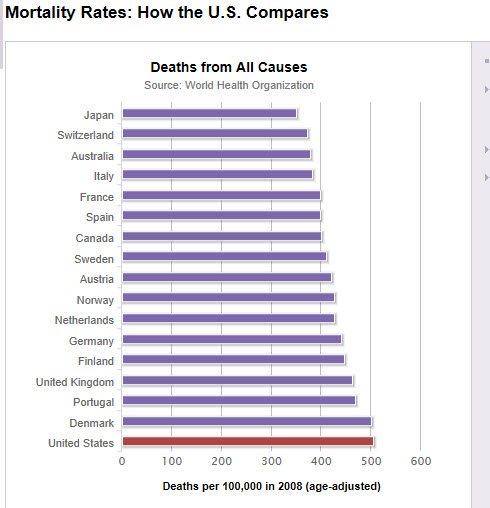
While thinking about changes in death rates it is also worth looking at what has happened to infectious diseases over the last 100 years.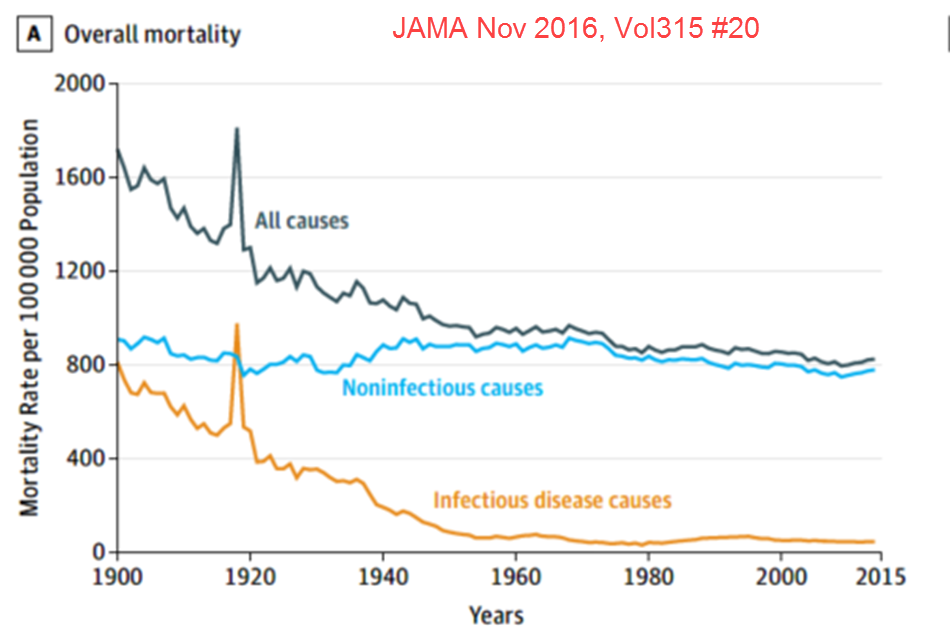
Then consider what happened to US death rates over the last 40 years
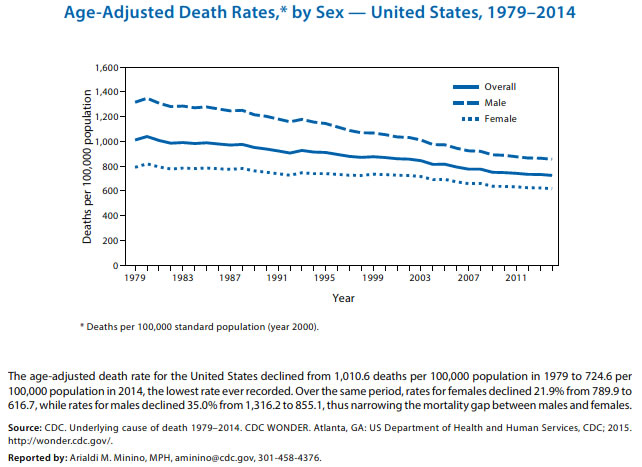
The Growing Crisis in the US.
However, chronic diseases are also a global crisis, also see this article from Nov 2011 Health Affairs on the international burden.
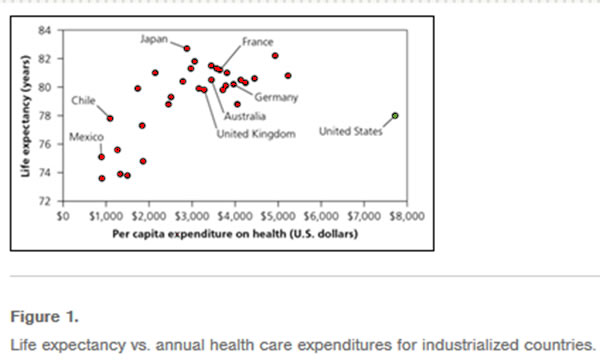
Data from the Statistics program of the OECD, 2014
NEJM-Feb 2010-Comparative Effectiveness and Health Care Spending
Also scan this summary report from the Coucil on Foreign Relations with particular attention to the graphics. You can also scan the entire report here.
Millken Institute Report on Economic Burden of Chronic Disease (Pages 8-12)
SickCare to Health Care- Re-engineering the system.
2008-Tracking the Care of Patients with Severe Chronic Illness; The Dartmouth Atlas of Health Care 2008
2008 WHO Executive Summary-The care of patients with severe chronic Illness
Eroding access to chronic disease, 10 years of change. (Do you thimk the ACA 2010 has changed this issue). Look at this 2015 comment on the subject., also this BMJ editorial on research.
The Burden of Chronic Disease, Bodenheimer et AL. (Focus on exhibit 1,2 and concepts, not details). Yet all is not lost; see this NYT editorial.
Also Review these two articles, one an editorial, and a longer editorial also from JAMA on the global burden in the US. Also, you can view the global burden as seen from the World Health Organization and should keep this article available during the entire course, so you can dip into it from time to time to look at points of interest rather than trying to read the whole material at one sitting. In addition, look at this summary of information from the IOM on quality measures for population health and keep this in mind during the entire course.
Chronic pain is a major element of many of the chronic diseases, review the summary (pages 17-32. in particular Box S1, and public health role) from this IOM publication.
Bias is often a problem in many studies, particularly for chronic diseases, review this commentary from Cochrane studies (Particularly tables on Pages 6-8).
HHS Initiative on Multiple Chronic Conditions, inparticular select the Goals option and scan these for use in your presentations.
A Global Crisis JAMA May 2012
Living Well with Chronic Disease. IOM. Read the forward (Page 10), Scan Abstract, and Summary(Page 16-39)
Multimorbidity Challenge Lancet 2012
One of the important issues starting to permeate everyone's conscience is the need to develop a culture where everybody concerned about their own health as well as everyone else's, and the health of the nation. The following data graphic from the November 2016 issue of health affairs gives you the first look at this concept:
One of the issues that is important in working with chronic dseases is understanding relation between education and health. Scan Pages 1-8. Also scan Chap 2 of Health Literacy and Public Heath
Reducing Chronic Disease :Goals (Lancet on measuring progress)
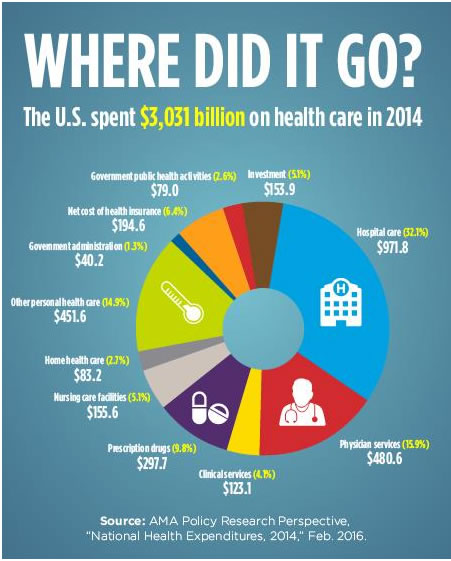
Scan the Journal "Health Affairs" for December 2010. When using the TML E-journal web site after entering 'Health Affairs'. I realize that much of this issue of Health Affairs deals with international; health but the lessons apply to the US as well. Particularly look at the article "in technology we trust" and Comparative Effectiveness research.
Use "America's Health Rankins " data when considering each chronic disease and the role behaviors contribute to each chronic disease. Dip into this PBS video on dying.
Vital Signs Infographic from IOM Note the per person cost of care conpared to the oither recent studies.
Read the executive summary of "Preventing Chronic Disease: A Strategic Framework" and scan boxes, particularly Box 1, page 10. Also scan this review of a new book on the History of Chronic Diseases. which discusses evidence on treatment of chronic disease from prechristian eras to today. Now, from the CDC are sets of data on the behavioral aspects of various chronic diseases from 500 cities. Look at this data in regard to the data on your own city and state as we discuss each of the forthcoming topics.
As we focus on prevention we need to start thinking about the issue of both population and personal health. This data graphic from November 2016 issue health affairs is useful in helping frame the issue. You may want to look at the Journal to the TML library and read the second article in the November issue.
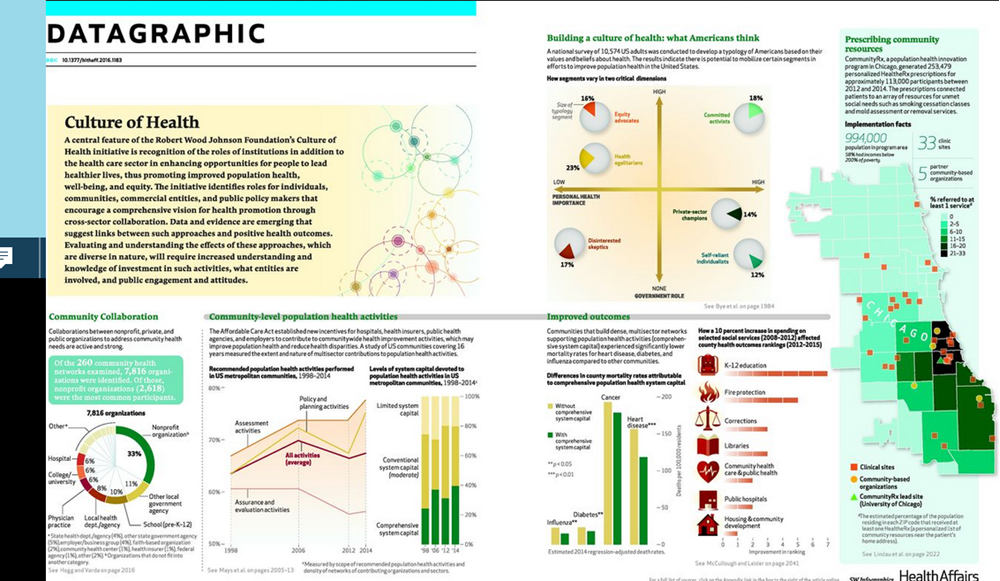
Resource on Chronic Disease from the TML Library
A great new resource for article analysis, as well as preparation . Research Methods Supercourse Introduction
Atlas of United States Mortality.
Finally take a look at this recent publication in JAMA at the end of 2016 which looks at US death rates by County across the United States by type of disease and location to get a feel for the variation. consider why this may be.
When dicussing weekly URLs remember these two papers,first on safer trials, and second on treatment of complex problems and need to understand medical literacy. Also BMJ Editorial on Primary Care Research, value of interventional stidies and two reviews on mortality changes and the need to evaluate them.
Discussion of weekly URLS.
ScienceDaily
